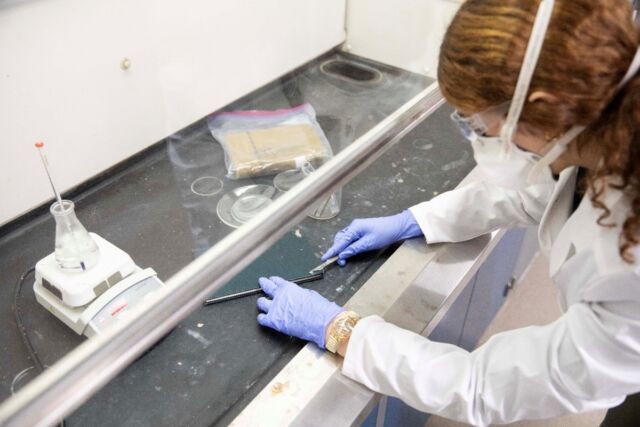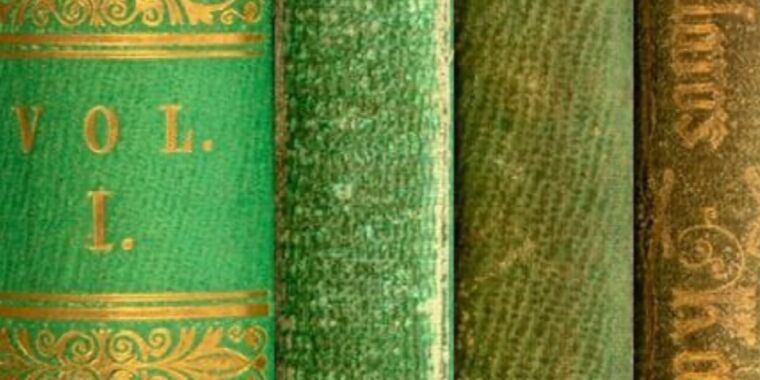
In April, the National Library of France removed four 19th-century books, all published in Britain, from its shelves because their covers were likely laced with arsenic. The books have been quarantined for further analysis to determine exactly how much arsenic is present. It’s part of an ongoing global effort to test linen-bound books from the 19th and early 20th centuries because of the common practice of using toxic dyes during that period.
Chemists at Lipscomb University in Nashville, Tennessee, have also been studying Victorian books from the university's library collection to identify and quantify the amount of toxic chemicals in their covers. They reported their initial findings this week at a meeting of the American Chemical Society in Denver. Using a combination of spectroscopic techniques, they found that several books had lead concentrations more than twice the limit set by the U.S. Centers for Disease Control (CDC).
The Lipscomb effort was inspired by the University of Delaware’s Poison Book Project, which was founded in 2019 as an interdisciplinary, crowdsourced collaboration between scientists at the university and the Winterthur Museum, Garden, and Library. The original goal was to analyze all Victorian-era books in Winterthur’s Circulating and Rare Books Collection for the presence of an arsenic compound called copper acetoarsenite, an emerald green pigment popular at the time for dyeing wallpaper, clothing, and fabric book covers. Book covers dyed with chrome yellow, favored by Vincent van Gogh and also called lead chromate, were also examined, and the project’s scope has since expanded globally.
The Poison Book Project is still ongoing, but 50 percent of the 19th century cloth bindings tested so far contain lead in the cloth in various colors, as well as other highly toxic heavy metals: arsenic, chromium and mercury. The affected books from the French National Library include the two-volume Ballads of Ireland by Edward Hayes (1855), an anthology of translated Rumanian poetry (1856), and the Royal Horticultural Society's book of 1862–63.
The levels were particularly high in the compounds containing chrome yellow. However, the project researchers also found that, at least for now, the chrome and lead in chrome yellow-dyed book covers are still bound to the fabric. The emerald green pigment, on the other hand, is very “friable,” meaning that the particles break apart even with small amounts of tension or friction, such as rubbing or brushing against the surface. And that pigment dust is hazardous to human health, especially when inhaled.

Kristy Jones
The project includes several recommendations for the safe handling and storage of such books, such as wearing nitrile gloves (for example, prolonged direct contact with arsenic green pigment can lead to skin lesions and skin cancer) and not eating, drinking, biting nails, or touching the face while handling, as well as thoroughly washing hands and wiping down surfaces. Arsenic green books should be isolated for storage and removed from circulating collections if possible. And professional conservators should work under a fume hood to limit their exposure to arsenic pigment dust.
X-ray diffraction marks the spot
In 2022, Libscomb librarians heard about the Poison Book Project and approached the chemistry department to conduct a similar analytical study of the 19th-century books in Beaman Library. “These old books with toxic dyes in them may be in universities, public libraries, private collections,” said Abigail Hoermann, a Lipscomb University chemistry graduate student involved in the project, led by chemistry professor Joseph Weinstein-Webb. “So we want to find a way to make it easy for everyone to figure out how often they’re exposed to these books and how to store them safely.”
The team relied on X-ray fluorescence spectroscopy to conduct a broad survey of the collection to determine the presence of arsenic or other heavy metals in the covers, followed by plasma-optical emission spectroscopy to measure the concentrations in clipped samples of book covers where such poisons were found. They also took their analysis a step further by using X-ray diffraction to identify the specific pigment molecules in the detected toxic metals.
The results so far: Lead and chromium were present in several books in the Lipscomb collection, with high levels of lead and chromium in some of those samples. The highest lead level measured was more than twice the CDC limit, while the highest chromium concentration was six times the limit.
Lipscomb Library decided to seal all untested colored 19th century books in plastic for storage pending analysis. Those books, now known to have covers colored with hazardous dyes, were removed from public circulation and also sealed in plastic bags, following recommendations from the Poison Book Project.
The XRD test showed that lead(II) chromate was also present in some of those heavy metals, a compound of the chrome yellow pigment. In fact, they were surprised to find that the book covers contained much more lead than chromium, since there is equal amounts of both in lead(II) chromate. More research is needed, but the working hypothesis is that there may be other lead-based pigments, lead(II) oxide perhaps, or lead(II) sulfide, in the dyes used on those covers.

